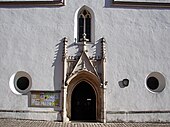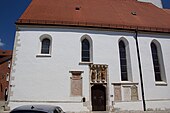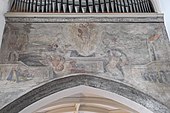St. Barbara (Abensberg)
The Roman Catholic parish church of St. Barbara in Abensberg , a town in the Lower Bavarian district of Kelheim , is a late Gothic hall church that was started in the 15th century and completed at the beginning of the 16th century. The church consecrated to St. Barbara of Nicomedia is one of the protected architectural monuments in Bavaria.
history
The parish Abensberg was on Michaelmas day , September 29, 1380, by the then Regensburg Bishop Konrad VI. von Haimberg after the city rights of Abensberg had been confirmed by Duke Stephan II of Bavaria in 1348 . Before that, the area belonged to the original parish of Gögging . In the early days, today's branch church of the Assumption of Mary served as a parish church in the Aunkofen district . As a result of the establishment of the Carmelite monastery with a church from 1389, the still young parish was forced to build its own parish church in the city center. Construction probably began around 1400 and was completed around 1450. Originally it was a hall church . It was not until 1516 that the church was rebuilt and vaulted by a master Ludwig from Pfeffenhausen into a three-aisled hall church , as is often found in town churches in southern Bavaria . The round pillars between the aisles , which were drawn in during this measure, could have stood symbolically for the trees of the paradise garden, as plant motifs could also be exposed in the vault of the south aisle. During this transformation, a larger than life fresco of St. Christopher near the north portal was damaged; Even in the 19th century the head of the saint is said to have been clearly recognizable under the church roof.
In the course of the baroque period , the original, late-Gothic furnishings were gradually replaced. The present pulpit was purchased in 1698, the choir stalls in 1726 - today the only remaining pieces from the Baroque period. After the tower was destroyed by lightning in 1731, it would take 31 years before a new building was built. The master builder was Christoph Wolf from Stadtamhof , who a year later also redesigned the tower of the Weltenburg monastery church and gave it a very similar appearance. Together with the master carpenter Kaspar Stuber from Rohr, he built the new tower superstructure. 1797 to set a Baroque high altar on the local carpenter Georg Kobel Stetter, the 1879 re-gothicised (1862-1885) fell below pastor Georg Ott victim. Only the balustrade and the communion bench are preserved from the Neo-Gothic period . In 1929 today's high altar was erected. With the removal of the neo-Gothic side altars in 1956, the parish church received its current appearance. The last renovation was carried out in 2002.
architecture
Exterior construction
The three-nave church of a gable roof covered. The choir and nave are broken up by pointed arched windows. The bell tower rises in the northern corner of the choir, the square substructure of which dates back to Gothic times. The upper floor of the tower is structured by pilasters arranged in pairs , the edges are provided with covings . Above a richly profiled ledge, the tower closes with a Welschen dome , which is crowned by a pyramid. The sacristy is built to the east of the tower .
Portals
The church has three entrances : the west portal, which is approached from the town square, the south portal to Barbaraplatz and the north portal, which recently received a modern porch with a staircase leading to the gallery . The nativity scene , some of the figures of which date from the Baroque period, is also housed in this vestibule . The ogival west portal is integrated into a flat wall niche with a ribbed vault . It is surrounded by a limestone frame in the shape of an eyelash with a finial and lateral pinnacles . A canopy niche has been cut above the south portal, which is also framed by limestone and is vaulted by a basket arch . The consoles with winged mythical creatures come from the Gothic church building. The figures represent St. Emmeram von Regensburg (left), St. Barbara (center) and St. Wolfgang von Regensburg (right), they were renewed in the 1980s.
inner space
The nave consists of a three-aisled hall divided into five bays , to which a retracted choir adjoins in the east with a five- eighth end. A pointed choir arch leads to the chancel , which is slightly wider than the central nave and includes two bays. The main and side aisles are spanned by ribbed vaults, the ribs of which grow from slender round pillars without capitals . The western nave yoke is occupied by the organ gallery, which extends over all three naves. The rows of pipes are arranged in the two side aisles.
Murals
A late Gothic wall painting from the middle of the 15th century was uncovered in 1956 on the front of the south aisle, on the site of the then removed right side altar. St. Achatius is depicted on it, flanked by St. Barbara (left) and St. Catherine (right). Above it, a much larger painting shows St. Leonhard as the liberator and intercessor of the prisoners.
There are three more wall paintings on the front wall of the west gallery. According to the name, these were created in 1585 and were already exposed before the Second World War . The themes from south to north are: the baptism of Jesus , the Last Judgment and the resurrection of Jesus .
Furnishing
Altars
The church's current high altar, carved from linden wood, dates from 1929. It was donated by the innkeepers of the Kuchlbauer inn , Michael and Babette Salleck, and made by Georg Schreiner. It should combine the styles represented in the church: the structure as a winged altar is reminiscent of the Gothic, the somewhat rigid ornamentation is reminiscent of the Baroque. The figural representation of Christ as King in the excerpt from the altar is the introduction of the Christ the King by Pope Pius XI. owed in the holy year 1925. When the altar wings are folded out , two reliefs can be seen to the left and right of the tabernacle ; these show from left to right the birth of Christ , the beheading of St. Barbara , the martyrdom of St. Sebastian and the adoration of the Magi . During Lent , the altar wings are closed so that the paintings on the reverse of Christ on the Mount of Olives (left) and Christ at rest (right) can be seen. The artist of these two works is Hermann Spatz (1899–1973) from Germersheim , whose works were largely destroyed in the Second World War. Folk altar and ambo are modern. As people's altar in 1929 made the high altar by Georg Schreiner is credenza used; the ambo was made from parts of a wrought iron lattice door of the communion bench, which the local master locksmith Michael Reithmeier created in 1928 or 1929.
Pulpit and choir stalls
The baroque pulpit on the first northern pillar was added in 1698. The body is decorated with winding pillars and shell niches containing the figures of Christ and the four evangelists . A pope figure can be seen on the sound cover , which is supposed to represent the church father Gregory the Great . The carvings are made by the artist Anton Schnidtmann from Neustadt an der Donau , the figures by the Essingen sculptor Ulrich vor. During the chaos of war in 1945, an explosive device hit the north wall of the parish church; Due to the force of the detonation , the pulpit fell into the aisle and was badly damaged. After the war, however, the pulpit could be restored true to the original. The choir stalls , which are also baroque, date from 1726.
Sculptures and figures
In the chancel there are various paintings that belonged to earlier high altars: the martyrdom of St. Barbara (around 1797) and the martyrdom of St. Sebastian (1765) from the baroque high altar, both on the north wall, as well as St. Barbara in Nazarene style (1869) , painted by Joseph Valentin (1811–1895) for the neo-Gothic high altar on the south wall. In addition, various figures, which are also taken from earlier altars, decorate the choir. Today's high altar is flanked by the apostles Peter and Paul , and Saints Nicholas , Wolfgang, Katharina and Margareta can also be seen. At the choir arch there is a baroque crucifix with a self- supporting loincloth, which was carved at the beginning of the 18th century.
Along the two side walls of the of the court painter's Christian Wink (1738-1797) created the crossroads cycle in the Rococo style seen. Below the first south window is a copy of the miraculous image of the former pilgrimage church Sankt Gilg am Moos , which was demolished during the secularization . One of the oldest and largest folk festivals in Bavaria , the Abensberg Gillamoos, is derived from this . In addition, a figure of St. Christopher with the baby Jesus and - above the south portal - a crucifixion group can be seen in the south aisle . While the crucifix dates from the early 20th century, the early Baroque assistance figures Maria and Johannes from around 1600 are attributed to a master Öllinger from Regensburg .
The war memorial can be seen on the north side under the gallery , an early work by Georg Schreiner, who later carved the representation of the high altar. The neo-baroque monument is adorned with a half-length figure of Saint Barbara as patron saint with a chalice and host . Above the north portal is a painting in the Nazarene style in a neo-Gothic pointed arch frame, Saint Anthony of Padua , to whom the baby Jesus appears. On the north wall of the nave there is a rococo figure of St. Wendelin by the sculptor Johann Georg Rothmayer and a baroque Pietà . Instead of the north side altar, you can see a late Gothic sculpture of a Madonna and Child from around 1450. Since the Mother of God hands the baby Jesus an apple, she symbolizes the new Eve . Two angels stretch a canopy-like veil in Mary's back. The group of figures is accompanied by the secondary figures Franz Xaver (left) and Ignatius von Loyola (right), both late Rococo sculptures from around 1785. These are attributed to the local sculptor Johann Gallus Weber (1751–1807), and others Works are located in the parish church of St. Andreas in Pürkwang and in the pilgrimage church of Bettbrunn .
organ
Today's organ - the fifth in this church - was built in 1961 by the Michael Weise company from Plattling , with parts of the previous instrument being reused. The four sub-works are located at the left and right end of the gallery. The instrument has 28 registers , divided into three manuals and pedal .
Peal
The parish church has a six-part Salve-Regina bell with the tone sequence as 0 -c 1 -es 1 -f 1 -as 1 -b 1 . The seventh and smallest bell, which dates back to 1732, is not part of the main bell and is only rung as a death bell.
Existing peal
| No. | Surname | Casting year | Caster | Weight [kg] |
Percussive ( HT - 1 / 16 ) |
|---|---|---|---|---|---|
| 1. | Barbara's Bell | 1947 or 1949 | Johann Hahn, Landshut | 3550 | as 0 +4 |
| 2. | Marienbell | 1902 or 1921 | 2000 | c 1 -? | |
| 3. | Patrona Bavariae bell | 1947 or 1949 | 1078 | it 1 -6 | |
| 4th | Michael's Bell | 741 | f 1 -4 | ||
| 5. | Joseph Bell | 433 | as 1 +6 | ||
| 6th | Brother Konrad bell | 304 | b 1 -2 | ||
| 7th | Death bell | 1732 | Johann Sedlpaur, Straubing | ? | ? |
Funerary monuments and reliefs of the Mount of Olives
The grave of the Abensberg pastor and licensee of theology , Ignatius Ponschab (1765–1787), who belonged to the Jesuit order until its dissolution in 1773, is located under the image of the grace of Gillamoos . At about the same place on the outside is the grave slab for the Augustinian canon Ambrosius Mindl from the Indersdorf monastery , who was pastor of Abensberg from 1794 until his death in 1799.
On the right side of the south portal a red marble epitaph with a relief commemorates the Abensberg pastor Erasmus Rabein, who died in 1500. Next to it is a limestone epitaph for Richilla Dorfpeck, who died in 1549 and the wife of Abensberg judge Stephan Dorfpeck. Above the inscription is carved a relief of an angel holding the arms of the couple. To the right of it you can see a sandstone tablet framed by pillars , which - already heavily weathered - shows the resurrection of Christ. To the left of the south portal, a relief plaque made of red marble is set into the outer wall, which bears the year 1498 and depicts Jesus with his disciples on the Mount of Olives .
Further tombs were moved to the vestibule on the north side in 2002 for conservation reasons.
literature
- Hans-Josef Bösl (Ed.): Sankt Barbara Abensberg - How it was and is . Abensberg 2005.
- Hans-Josef Bösl: Parish Church of St. Barbara Abensberg - historical career, spiritual profile . Abensberg 2012.
- Georg Dehio (edited by Michael Brix): Handbook of German Art Monuments. Bavaria II - Lower Bavaria . 2nd revised and supplemented edition, Deutscher Kunstverlag, Munich 2008, ISBN 978-3-422-03122-7 , pp. 1–2.
Web links
Individual evidence
- ↑ List of monuments for Abensberg (PDF) at the Bavarian State Office for Monument Preservation, monument number D-2-73-111-20
- ↑ a b c Hans-Josef Bösl: Parish Church of Sankt Barbara Abensberg - historical career, spiritual profile , pp. 6-10.
- ↑ a b c d e Hans-Josef Bösl: Parish Church of Sankt Barbara Abensberg - historical career, spiritual profile , pp. 22-26.
- ↑ a b c d e f Hans-Josef Bösl: Parish Church of Sankt Barbara Abensberg - historical career, spiritual profile , pp. 11-21.
- ^ Willibald Kerschensteiner: The organs in the churches of the parish of St. Barbara - Abensberg , in Hans-Josef Bösl (ed.): Sankt Barbara Abensberg - How it was and is , Abensberg 2005.
- ^ Abensberg, parish church of St. Barbara . Online at glockenklaenge.de. (accessed on July 17, 2016).
- ^ Abensberg (KEH) - St. Barbara: ringing for Sunday evening mass . Online at www.youtube.com. (accessed on July 17, 2016).
Coordinates: 48 ° 48 ′ 54.9 " N , 11 ° 50 ′ 49.1" E























